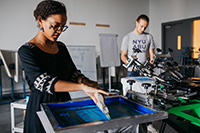The summer following Joseph Juma's (NYUAD '14) junior year was a busy one. During his semester abroad at NYU Polytechnic School of Engineering in New York, he was engrossed in a project on lightweight cement that contains styrofoam balls and worked under the tutelage of Associate Professor of Mechanical Engineering Nikhil Gupta.
Juma's research was focused on the development of lightweight cement syntactic forms and polymer matrix composites for aerospace applications. He studied the compressive properties of hollow, particle-reinforced cement composites with different modes of testing. Traditional cements often contain a material called fly ash, but by using carefully engineered glass cenospheres — lightweight inert hollow spheres — Juma was able to produce lightweight cement that had significant strength and stress properties.
A substance's tendency to deform elastically when a force is applied to it, also known as modulus of elasticity, was determined in each sample of cement and then correlated to both the volume fraction and density values of each model. Correlating the volume fraction to the density of the samples helped to establish a relationship between the volume and the type of glass cenospheres used, to the weight and modulus of elasticity of each of the samples.
Within each density-specific test, different percentages of glass microballoons were incorporated, along with a control group that contained only cement. Juma found that within each of the three density-specific studies, both the compressive strength and density decreased as the microballoon percentages increased.
Intrigued with the research work, Juma headed to Gupta's office to share his academic curiosities and research interest, and the discussion materialized into a full-time research project. By the end of the summer, Juma had modified the initial design of the experiments and tested mechanisms to ensure all the necessary tests were done before he returned for his senior year in Abu Dhabi.
As a civil engineering major, the opportunity to work in a mechanical engineering lab was a rewarding experience. "The caliber of the Ph.D. students in the lab, the helpful professor, and my colleague — fellow senior Mohammed Omar — all made this summer research a success," Juma said. In addition to maneuvering the technicalities of research design and gaining first-hand experience using mechanical equipment, Juma said he also learned the importance of patience in a controlled environment.
Lightweight cement syntactic forms is a relatively new and promising field, which provides Juma with great opportunity for future research: "I knew that I could break new grounds if I invested my efforts in it. The concept of lightweight cement is becoming more and more common and might be used for rapid deployment of structures in developing nations. The rapid deployment of structures could aid internally displaced people who might need immediate semi-permanent sheltering."
This article originally appeared in NYUAD's 2013-14 Research Report (13MB PDF).


